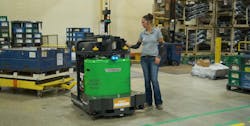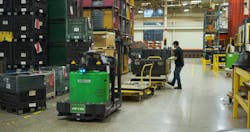With forward-looking manufacturers looking at ways to drive down costs and boost productivity, warehouse automation has emerged as a leading contender for digital transformation. Principal among them has historically been the AGV (autonomous guided vehicle), which can automate simple, single tasks via predefined warehouse routes.
However, as the manufacturing sector grapples with an ongoing labor shortage and other evolving business needs, it’s clear a more adaptable robot is needed to keep up with the fast pace of the industry. The autonomous mobile robot (AMR) has demonstrated its ability to address multiple warehousing needs independently, making it ideal for the warehouse of the future.
Following are highlights of the principal differences between AGVs and AMRs and how warehouse operators can identify the best options for their unique needs.
Warehouse navigation
Upon their emergence in the 1950s, AGVs relied on sets of predetermined routes, typically denoted by magnetic tape or other floor indicators acting as a “track” for the robot to adhere to. Modern-day AGVs still rely on this method today. Although this navigation strategy was pivotal to the success of the robots, it can present challenges to throughput and operations in modern warehouses.
AGVs are designed so that when they encounter an obstacle in their path, they are programmed to either slow down or immediately come to a hard stop, alerting human operators for assistance. In many cases the AGV is unable to move forward until an operator can manually clear the path—a significant burden in the fast-paced nature of the warehouses where workers are under pressure to process pallets in a timely fashion.
Unlike AGVs, AMRs are not required to follow preset paths and instead rely on guidance from an internal facility map stored within their navigation system. By leveraging this technology, AMRs can nimbly traverse warehouses, avoiding obstacles and applying minor path corrections. For unique situations that require major path correction, AMRs can plot out a new path without the assistance of a human operator. This self-sufficient method of path planning enables the robot and human operators to save valuable time that would have been spent manually adjusting the robot and path.
Safety measures
The modern warehouse is a complex system of moving parts characterized by human workers, pallets, large infrastructure, conveyor belts and, of course, robots. This environment requires technology that not only boosts throughput, but also makes human safety its top priority. AGVs typically use sensors to navigate their paths and avoid collisions with human workers. However, the limited sensor capabilities on many AGVs can still lead to safety incidents.
An AMR vision system with LiDAR (laser) sensors enables it to safely traverse the warehouse environment. Additionally, these sensors team up to create full 3D sensor fusion perception that facilitates the robot’s 360? view of its surroundings, allowing it to navigate bulk stacks and deep staging lanes. Furthermore, many AMRs have gone beyond these existing safety measures and invested in a multi-level safety architecture that combines hardware and software to form virtual barriers that keep robots away from the danger zones without requiring significant input from human workers.
Interoperability
As more manufacturers invest in digital transformation, companies will increasingly invest in a diverse mix of products from different vendors. That’s why it’s critical that any robot purchased can communicate and integrate efficiently with other forms of technology and software in use. Some AMRs are being designed and tested to integrate with other warehouse technologies under what is known as the MassRobotics interoperability standard. This allow AMRs to share information with other robots, such as location and activity, regardless of whether they were produced by the same company. As a result, warehouse operators can further ensure the safety and efficiency of their warehouses as multiple robots navigate to their destinations and complete various tasks. Currently, AGVs cannot support such functionalities, limiting their ability to seamlessly integrate with other warehouse infrastructure.
Increased collaboration
AMRs are equipped with more user-friendly interfaces and higher tier safety architectures, so that workers can feel as comfortable working alongside robots as they would their fellow humans. This is critical as companies face more pressure to invest in worker satisfaction and technologies that are specifically designed to make workers lives easier and more fulfilling.
Cost savings
Traditional AGVs require a higher initial investment, due to their specific needs for careful pre-planned routes, which often require additional costs to pay for restructuring projects. In contrast, AMRs can be a more cost-effective option when accounting for their ability to self-navigate and plan routes without the need for pre-planned paths and associated programming. Additionally, due to their cloud-hosted software, many AMRs can be deployed immediately, allowing companies to quickly see a return on investment.
Josh Kivenko is chief marketing officer at Vecna Robotics.


